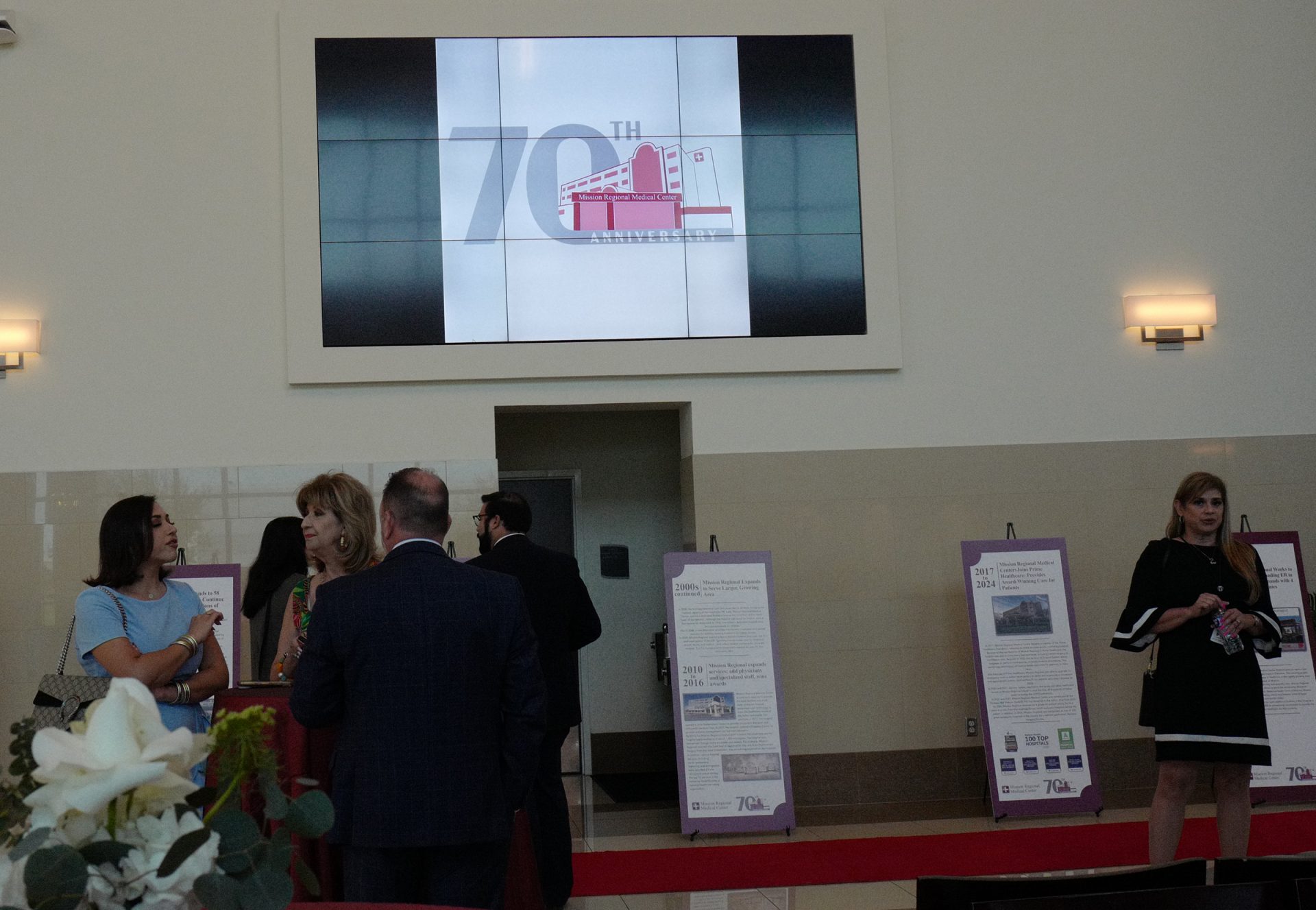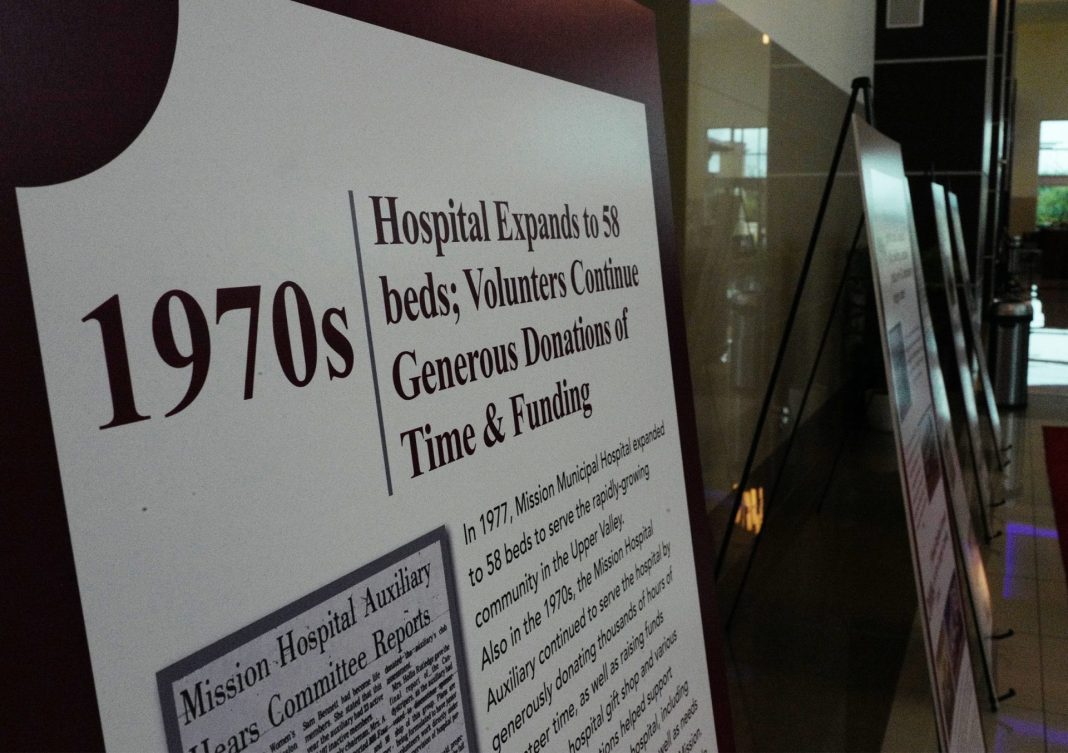|
Only have a minute? Listen instead
Getting your Trinity Audio player ready...
|

MISSION — A white canopy with a dazzling chandelier in the center stood at the entrance as guests made their way into the Mission Event Center on Thursday to celebrate Mission Regional Medical Center’s 70th anniversary.
The ceremony began with three words: Beacon of health.
Tables with maroon tablecloths filled the open space with panels timelining the history of the hospital’s expansion and contribution in the Rio Grande Valley over the decades.
Hospital officials gathered at the event center, located at 200 N. Shary Road in Mission, to commemorate seven decades of serving the community.
For Elizabeth Garza, 69, the event is a celebration of the hospital’s history of care that represents how the need for health care has changed through the years.
That history includes the hospital, originally named Mission Municipal Hospital, beginning as a 40-bed facility to now having 200 beds.
“It’s just amazing, you know where the community took the hospital,” Garza, who has been a board member for about 18 years, said Thursday.
A nonprofit community hospital, Mission Regional first opened its doors in July 1954 as a single-story facility, located at 1205 Bryce St., that offered emergency care, maternity, surgery and imaging services.
Prior to its first expansion in the 1970s, the facility had already begun to increase staffing and the equipment available.
In 1977, the hospital expanded to 58 beds at the Bryce Street location.

The facility later reached a milestone in their healthcare coverage when it opened its doors in January 1987 to its current hospital location on Bryan Road.
The 110-bed hospital at the time, which was accredited by the Joint Commission on Accreditation of HealthCare Organization, was staffed with 125 physicians that represented 27 specialties.
Other milestones for Mission Regional include the addition of the two-story medical office building in 1991, the addition of 28 beds for maternity and in-patient rehabilitation patients, a new emergency department, an ambulatory surgery center as well as a second medical office building.
The hospital system later built a five-story facility in 2004 with 132 beds for inpatient and outpatient rehabilitation services.
The new facility also included an intensive care unit, a step-down telemetry unit, a medical/ surgical floor, obstetrics and a neonatal intensive care unit.
As the hospital system continued to increase its presence across the Valley, board officials decided to change the hospital’s name in 2005 to Mission Regional Medical Center to reflect the scope of services available.
As time went on, Mission Regional continued to improve the equipment available such as investing in imaging technology, expanding its Neonatal Intensive Care Unit to 20 beds and increasing hospital bedding to 297 beds, opening a dedicated Pediatric Unit.
The facility also continued to expand its services by opening a Sexual Assault Forensic Examiner Unit in 2009 to care for victims of assault, abuse and neglect as well as collect forensic evidence for crime lab analysis.

By 2013, hospital staffing included 300 physicians with an overall workforce of about 1,000 employees.
In 2017, Mission Regional Medical Center became a member of the Prime Healthcare Foundation which allowed for more improvements to the facility and the services it provided such as the inclusion of robotic surgery.
“We moved with the times,” Garza said.
In 2020 and 2021, the facility was named one of the Fortune/ IBM Watson Health 100 Top Hospitals in the nation. Over the years the institution also received recognition for its services such as the Gold Seal of Approval for hip and knee replacement surgery from the Joint Commission.
The facility, which was ranked among the top 10% in the nation by HealthGrades, also received a five-star rating for services such as cardio-pulmonary, maternity and orthopedics.
“We’re always looking to expand the type of services that we offer,” Garza said. “We’re looking at opening a clinic west of Mission to continue to serve between Mission and Rio Grande.”
Padmini Bhadriraju, regional chief medical officer for Prime Healthcare in the Valley, which owns Mission Regional, Harlingen Medical and Knapp Medical centers, expressed enthusiasm about the work being done today.
“… It’s such a great team of people who work at Mission Regional, everyone is very dedicated and constantly looking for doing better things for patient care, safety and everything,” she said.




